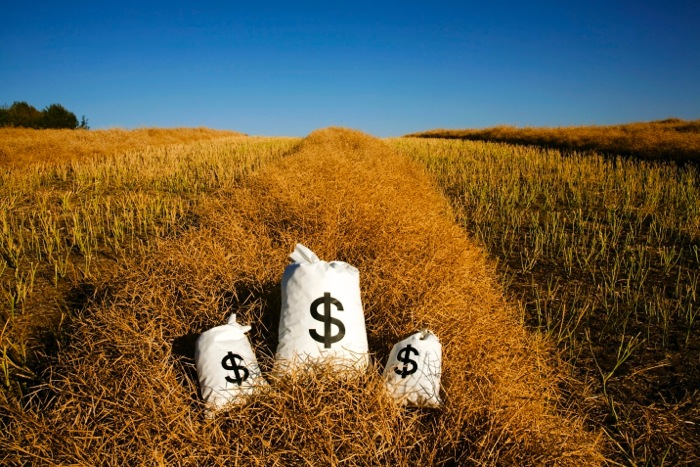Our last column introduced the concept of Earnings Before Interest, Taxes, Depreciation and Amortization (EBITDA) and used it to define Operating Efficiency Ratio, (EBITDA/Total Revenue). With some exceptions, financially successful farms have Operating Efficiency Ratios above 35 per cent, i.e. with at least 35 cents left from every dollar of sales after paying all non-capital operating expenses.
Using EBITDA in investment strategy
One aspect of financial strategy is your plan for growth based on how operating income (EBITDA) is invested. Many growth-oriented operations have a rule such as, after paying taxes, 40 per cent goes to new investment, 35 per cent goes to service debt and 25 per cent is to pay owners.
Read Also

Riding the tariff rollercoaster
Farmers are accustomed to roller-coaster years. But the current geopolitical windstorm is something else entirely. On his cattle operation near…
On such a farm, EBITDA is on a growth path because it is using 75 per cent of its operating income for new investment or debt service. By contrast, a farm that is reaching business maturity might have a rule putting more emphasis on income to owners and less on capital investment.
The important thing is to have a rule because it means you have a plan.
Using operating efficiency to diagnose operating problems
An interesting question that often arises is, if operating efficiency is less than 35 per cent, what’s the reason? What is causing it to be lower, and what needs to be done to fix it? This gives rise to a powerful application of the standardized operating statement and its attendant benchmark ratios.
Below we reproduce the standardized operating statement from our most recent article:
Gross Operating Revenue
- (-) Crop and Livestock Expenses
- (=) Gross Margin
- (-) Labour, Machine Operating Expenses, Land Rent
- (=) Contribution Margin
- (-) Management, Office and Overhead Expenses
- (=) EBITDA
- (-) Depreciation/Amortization
- (=) EBIT
- (-) Interest
- (=) Earnings Before Taxes
- (-) Taxes
- (=) Earnings After Taxes
- (+/-) Non-Core Income and Expenses
- (=) Net Income
Again, operating efficiency is the ratio EBITDA/Gross Operating Revenue. If one looks above the EBITDA line, it is apparent that three sets of costs are deducted from revenue to get to it: crop and livestock expenses; labour, machine operating, land rent; and management, office and overhead expenses.
There are also benchmarks for each category: crop and livestock expenses should be no more than 35 per cent of revenue; labour, machine operating, and land rent should be 15 to 20 per cent; management, office and overhead expenses should be no more than 10 to 15 per cent.
By definition, this means that Gross Margin should be 65 per cent or more of sales and Contribution Margin should be 45 to 50 per cent of sales.
Let’s assume that a farm has Operating Efficiency of 22 per cent, which is the Canadian average. What is keeping it from achieving 35 per cent? Why isn’t it generating more cash?
One way to diagnose this is to look at the other ratios. Assume the farm’s Gross Margin ratio is 57 per cent and its Contribution Margin is 45 per cent. What is this telling us?
First, because the difference between Gross Margin and Contribution Margin is only 12 per cent, this farm is doing a great job of managing operating costs in terms of labour and other operating costs. 15 to 20 per cent is the standard: this farm is beating it.
However, there is an issue with its Gross Margin. Its production expenses are 43 per cent of total revenue but the benchmark says they should be 35 per cent or less. The manager’s focus needs to be on production efficiency and/or marketing: the farm is not getting enough for what it’s selling, its conversion of inputs into products is underperforming and/or it is paying too much for inputs. Following back to the detail will probably pinpoint the exact problem.
Another farm with 22 per cent Operating Efficiency has 70 per cent Gross Margin and 33 per cent Contribution Margin. This farm has different problems. Crop and livestock costs are 30 per cent of revenue, better than the standard. But its operating costs are 37 per cent, far worse than the standard 15 to 20 per cent. The immediate focus for this operation will be on some combination of labour costs, other operating costs, and/or land rents. Also, when this category is this far off base, it may be that the farm is expensing equipment and machinery that should be depreciated. This makes operating performance worse than it should, and could have major repercussions for liquidity.
We find using this financial information and the benchmarks to be very powerful in helping managers manage well, and in undertaking realistic strategic and operating plans. The space available here prevents considerable nuance about application, but the examples are realistic given our experience with a number of farms.
While it is useful and important to evaluate your income statement and ratios each year, assessing that particular fiscal year, there is significant importance in also understanding and watching the trends and comparisons over a period of years and understanding why the costs and expenses in terms of percentages deviate from one year to another. Seeing the trend can identify successes or problems over time.
Larry Martin is co-owner and lead instructor in AME’s management training courses. Heather Broughton is co-owner and president of AME.















